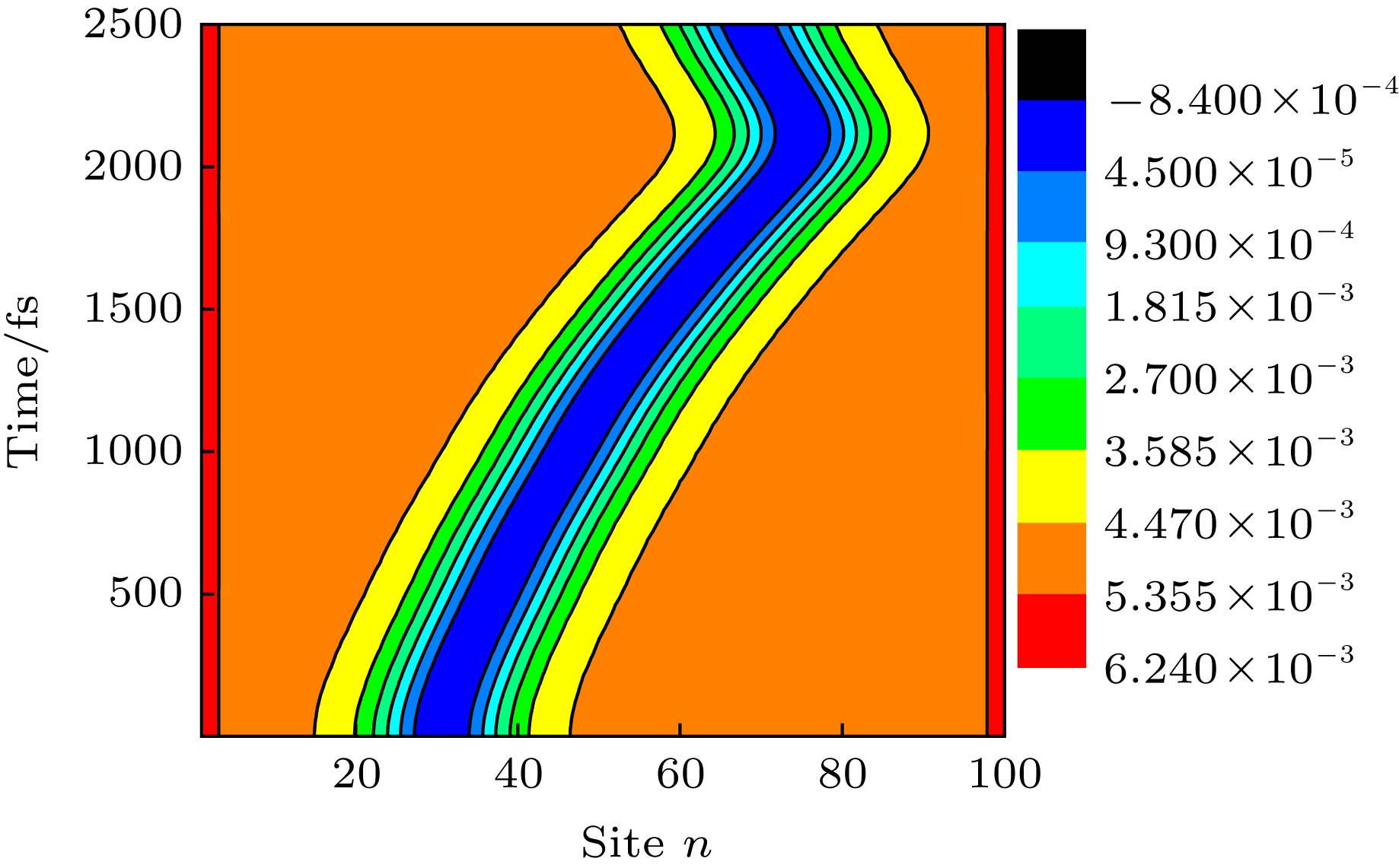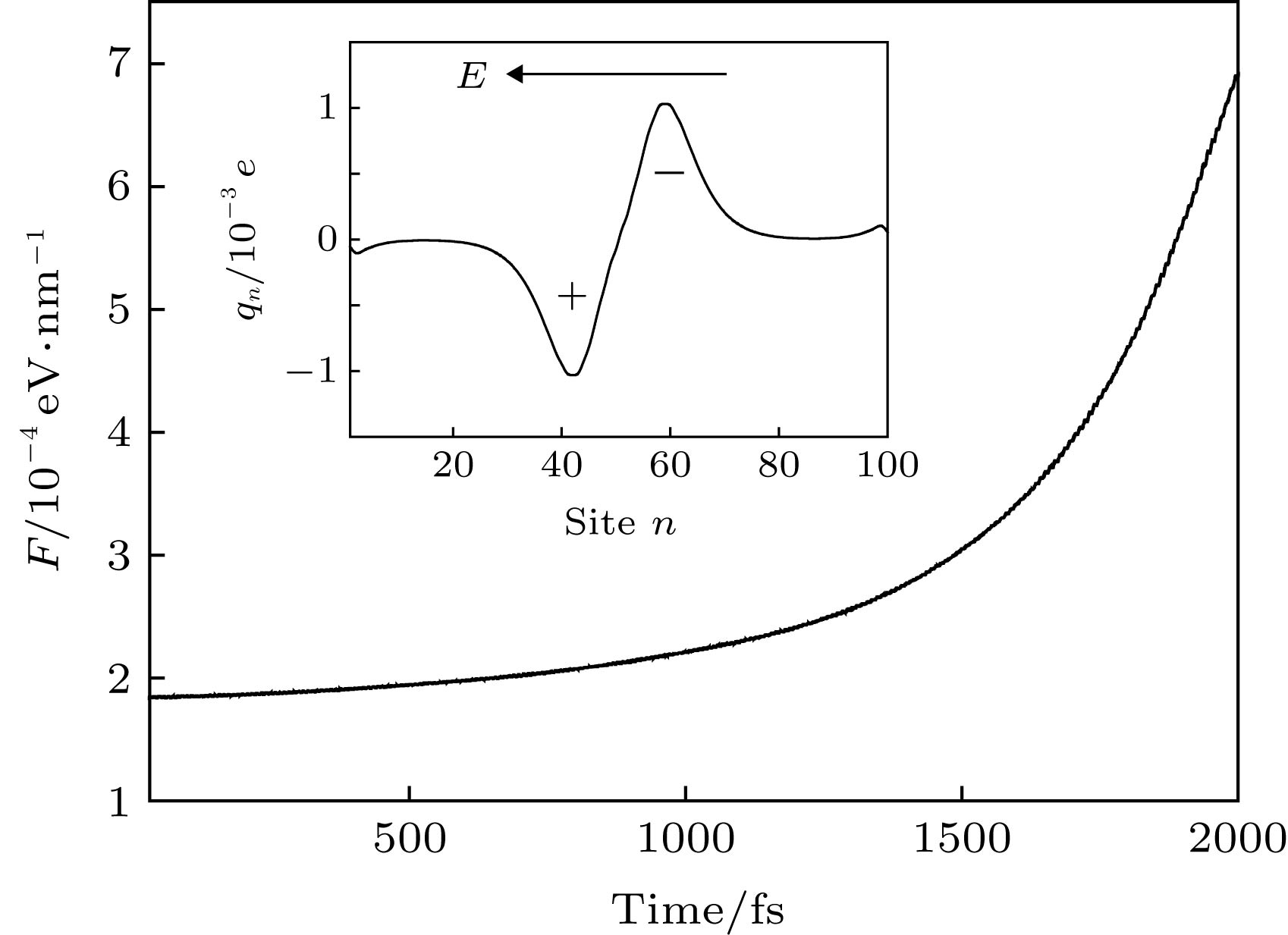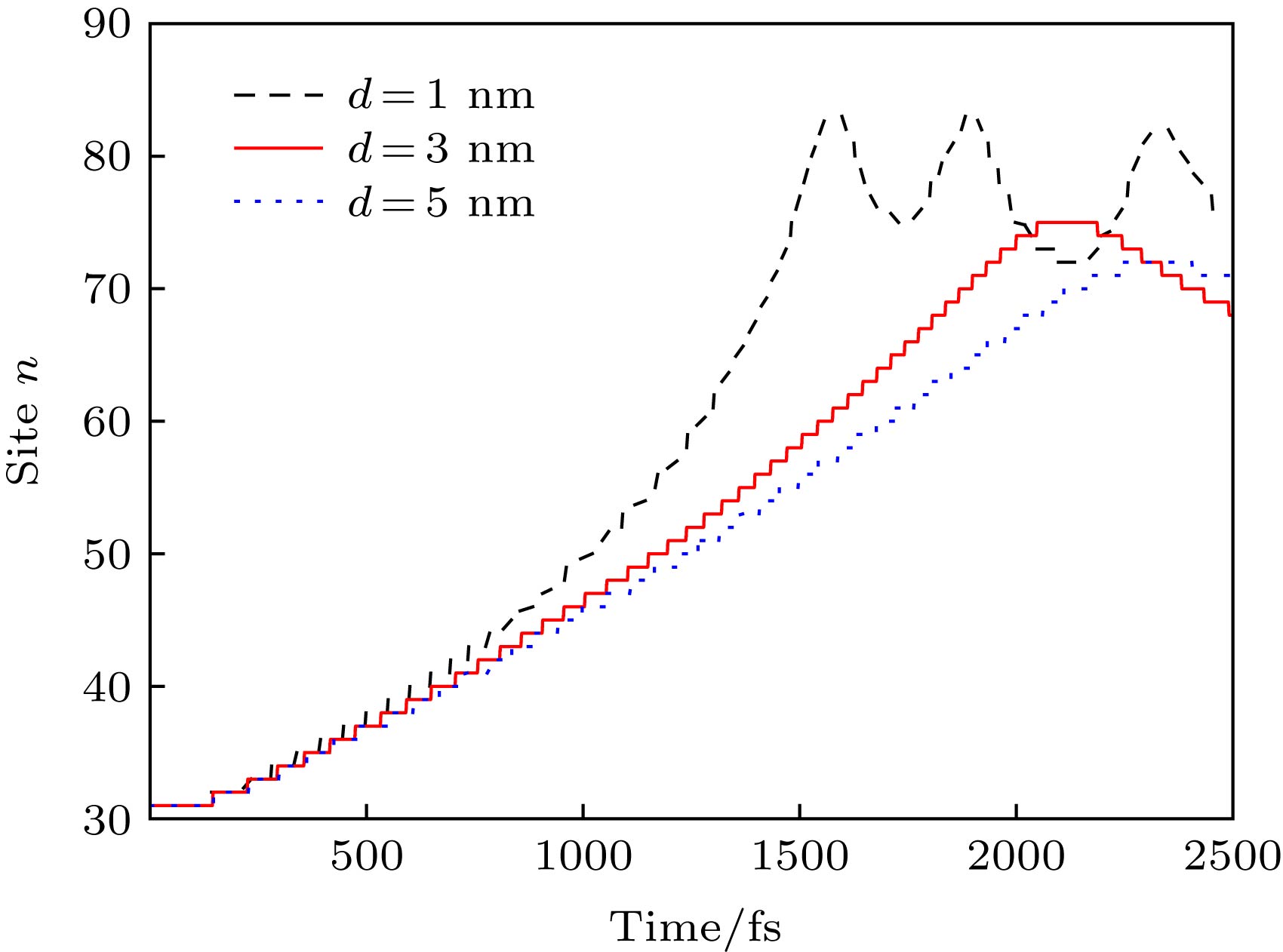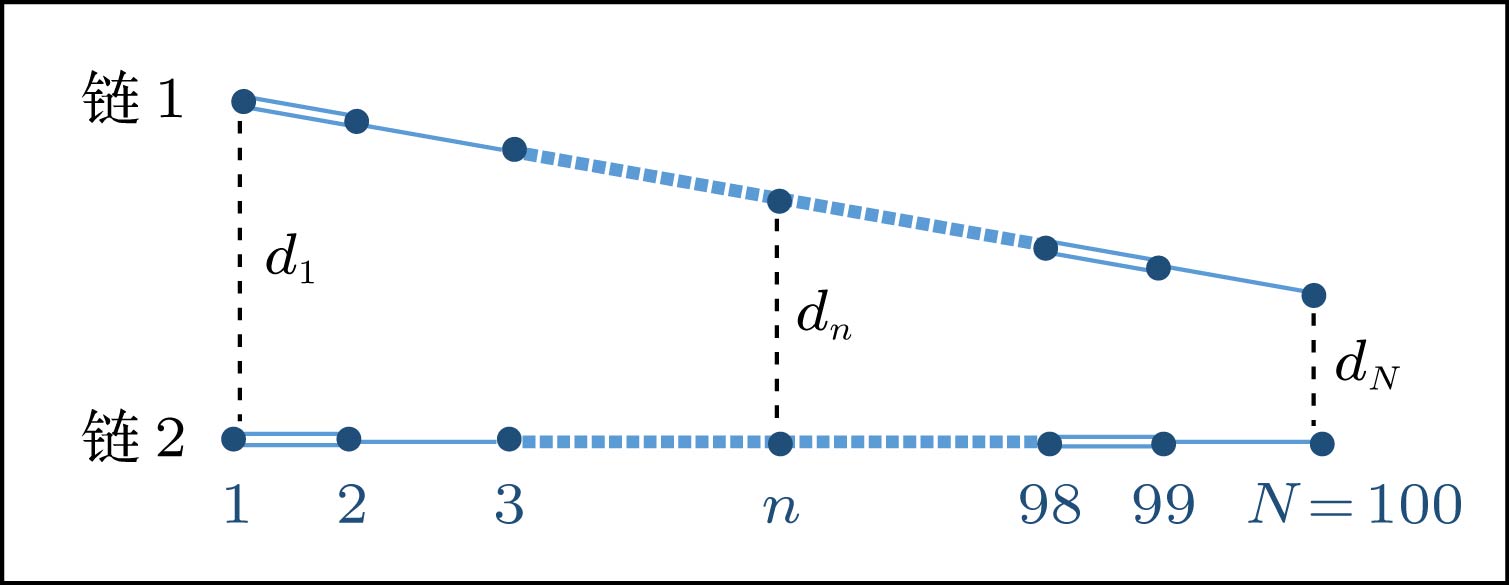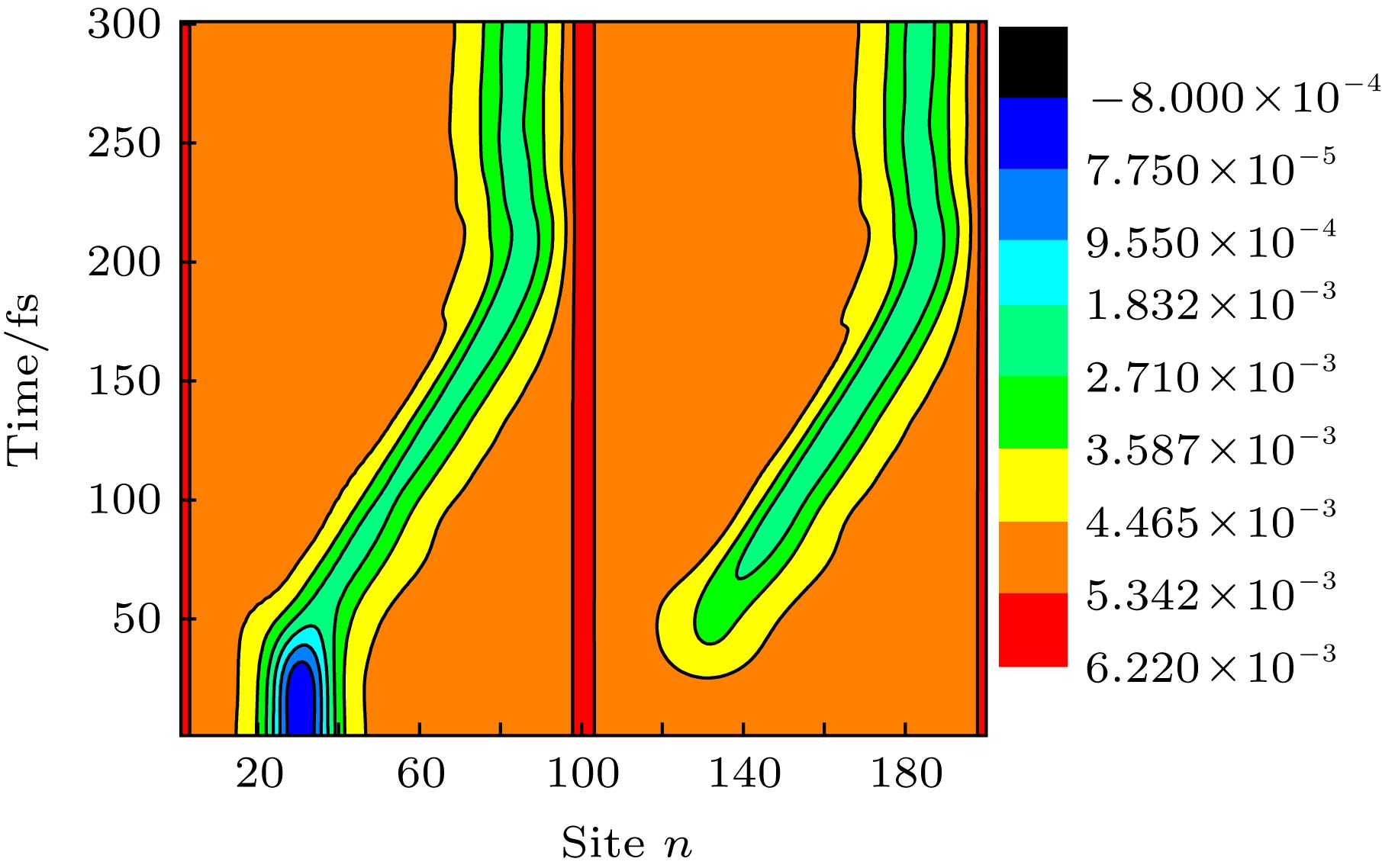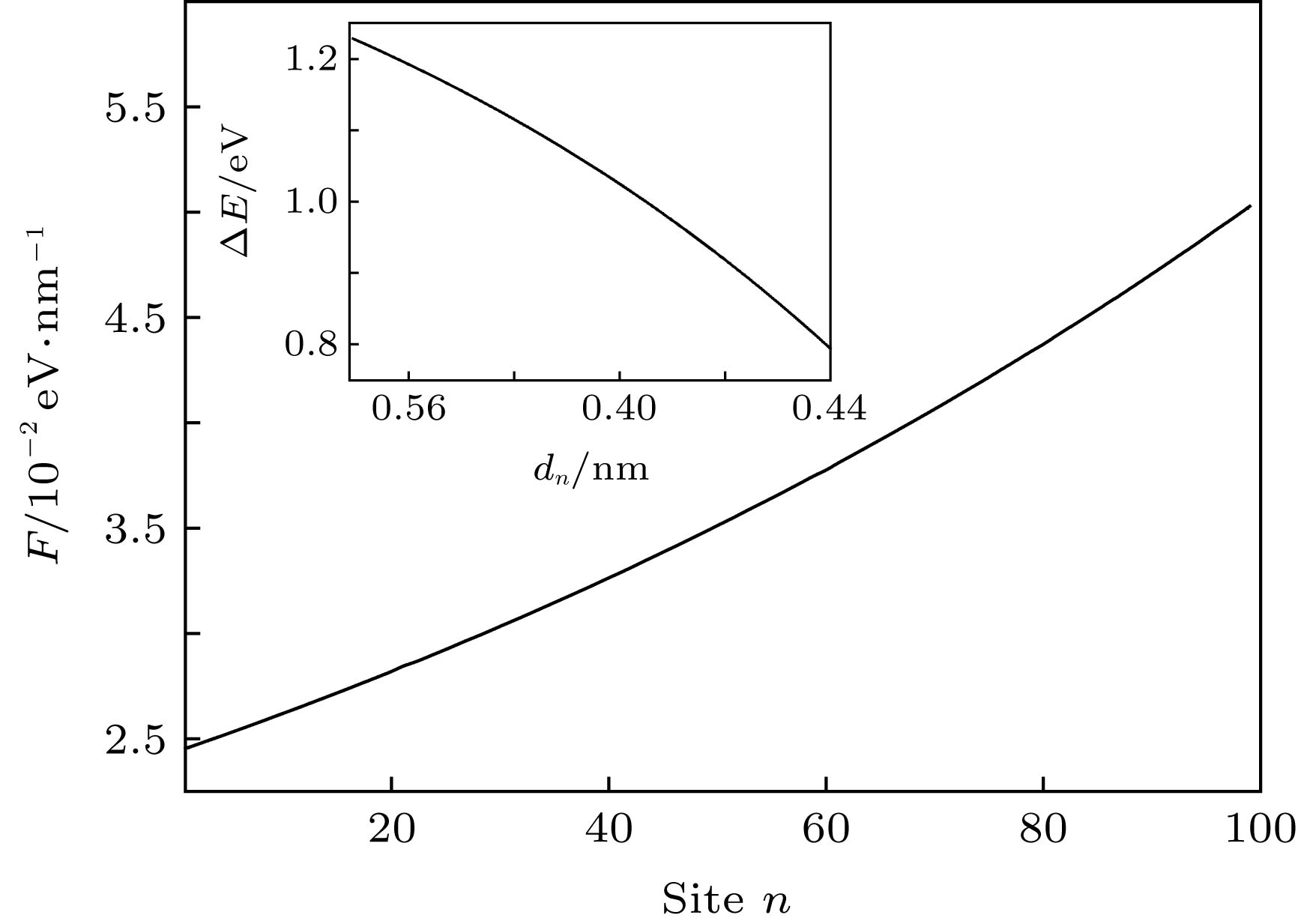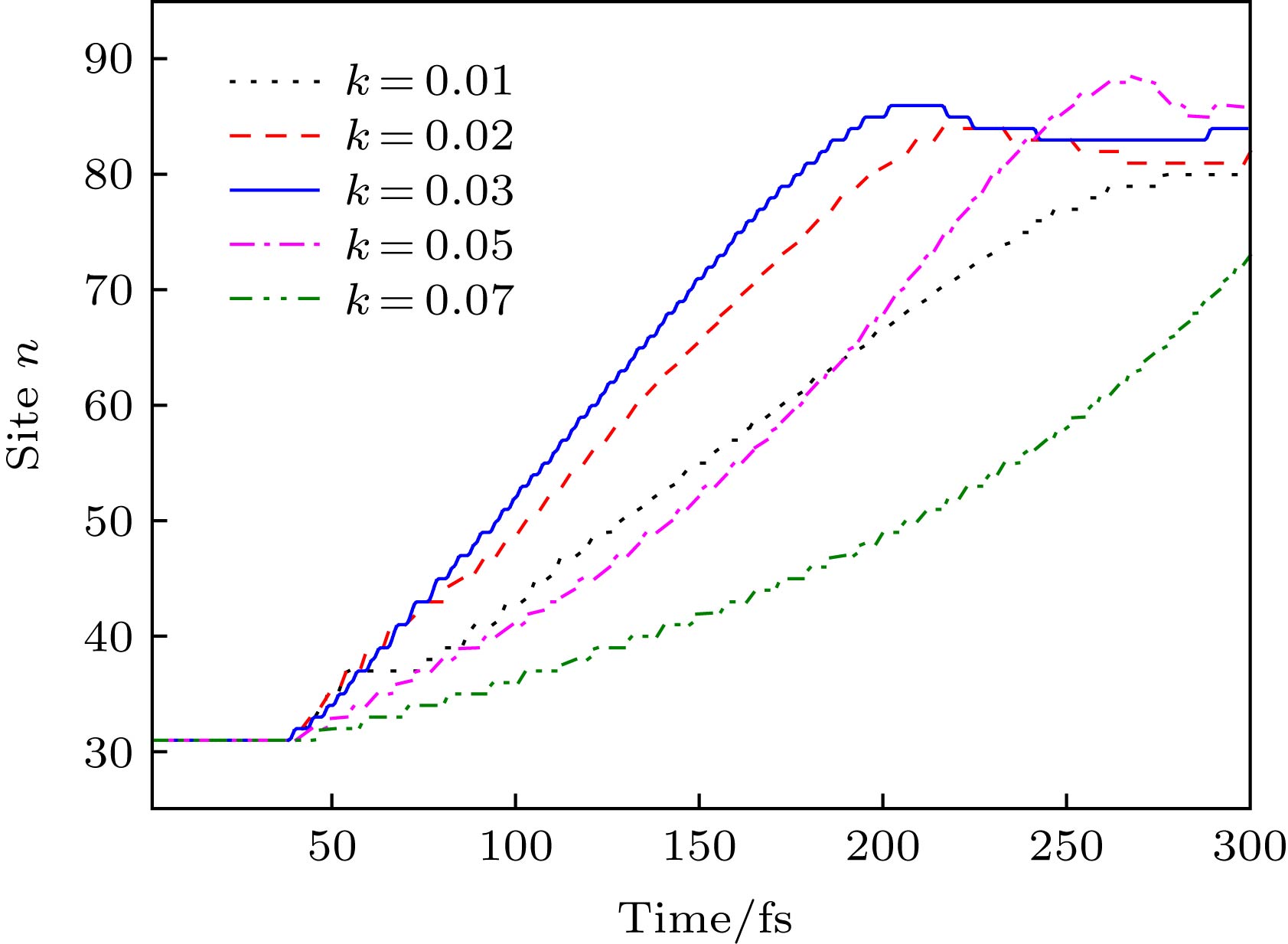-
Due to the exciton migration dynamics playing an important role in the photovoltaic process of organic solar cells, which are usually composed of polymer donor and fullerene (or non-fullerene) acceptor, in this paper we propose a new strategy to achieve the ultrafast exciton migration in polymers. Here, the effects of some nonuniform fields on the exciton migration dynamics in polymers are emphasized, such as the nonuniform electric field and the nonuniform polymer packing configuration field. Both of the two kinds of nonuniform fields can be intrinsically existent or modulated in an actual photovoltaic system. In this work, the nonuniform electric field and the nonuniform configuration field are assumed to be separately created by a confined charge and a linear polymer packing, therefore, their model Hamiltonian is established. In dynamical simulations of the exciton migration dynamics in polymers, an extended version of one-dimensional Su-Schrieffer-Heeger tight-binding model combined with a nonadiabatic evolution method is employed. It is found that the nonuniform electric field and the nonuniform configuration field both can drive exciton to an ultrafast migration process. Compared with the exciton migration speed dominated by the traditional Förster or Dexter mechanism, the exciton migration speed dominated by the nonuniform electric field and that by the nonuniform configuration field can be increased by one and two orders of magnitude, respectively. In addition, the driving mechanisms of the two kinds of nonuniform fields for the exciton migration dynamics are separately clarified, where the corresponding driving forces are also quantitatively calculated. Finally, in view of the factors affecting the distributions of the two kinds of nonuniform fields (such as the distance d between confined charge and polymer, and the linear packing slope k between polymers), we discuss their effects on the exciton migration dynamics. It is found that the exciton migration in polymer can be apparently accelerated by shortening the distance d between confined charge and polymer, and there exists a critical value of d, beyond which the exciton will be dissociated into free charges in its migration process. For the linear packing slope k between polymers, we find that there exists an optimal value, at which the exciton has the highest migration speed in polymers.
-
Keywords:
- polymers /
- photovoltaic effect /
- exciton migration
[1] Ameri T, Khoram P, Min J, Brabec C J 2013 Adv. Mater. 25 4245
 Google Scholar
Google Scholar
[2] An Q S, Zhang F J, Zhang J, Tang W H, Deng Z B, Hu B 2016 Energy Environ. Sci. 9 281
 Google Scholar
Google Scholar
[3] 於黄忠 2013 物理学报 62 027201
 Google Scholar
Google Scholar
Yu H Z 2013 Acta Phys. Sin. 62 027201
 Google Scholar
Google Scholar
[4] Yuan J, Zhang Y Q, Zhou L Y, Zhang G C, Yip H L, Lau T K, Lu X H, Zhu C, Peng H J, Johnson P A, Leclerc M, Cao Y, Ulanski J, Li Y F, Zou Y P 2019 Joule 3 1
 Google Scholar
Google Scholar
[5] Meng L X, Zhang Y M, Wan X J, Li C X, Zhang X, Wang Y B, Ke X, Xiao Z, Ding L M, Xia R X, Yip H L, Cao Y, Chen Y S 2018 Science 361 1094
 Google Scholar
Google Scholar
[6] Janssen R A J, Nelson J 2013 Adv. Mater. 25 1847
 Google Scholar
Google Scholar
[7] Cheng P, Zhan X W 2016 Chem. Soc. Rev. 45 2544
 Google Scholar
Google Scholar
[8] Bjorgaard J A, Köse M E 2015 RSC Adv. 5 8432
 Google Scholar
Google Scholar
[9] Scholes G D, Rumbles G 2006 Nat. Mater. 5 683
 Google Scholar
Google Scholar
[10] 王文静, 孟瑞璇, 李元, 高琨 2014 物理学报 63 197901
 Google Scholar
Google Scholar
Wang W J, Meng R X, Li Y, Gao K 2014 Acta Phys. Sin. 63 197901
 Google Scholar
Google Scholar
[11] Ruini A, Caldas M J, Bussi G, Molinari E 2002 Phys. Rev. Lett. 88 206403
 Google Scholar
Google Scholar
[12] Gao K, Liu X J, Liu D S, Xie S J 2008 Phys. Lett. A 372 2490
 Google Scholar
Google Scholar
[13] Kaake L G, Moses D, Heeger A J 2015 Phys. Rev. B 91 075436
 Google Scholar
Google Scholar
[14] Heeger A J 2014 Adv. Mater. 26 10
 Google Scholar
Google Scholar
[15] Dimitrov S, Schroeder B, Nielsen C, Bronstein H, Fei Z, McCulloch I, Heeney M, Durrant J 2016 Polymers 8 14
 Google Scholar
Google Scholar
[16] Förster T 1948 Ann. Phys. 2 55
[17] Dexter D L 1953 J. Chem. Phys. 21 836
 Google Scholar
Google Scholar
[18] Menke S M, Holmes R J 2014 Energy Environ. Sci. 7 499
 Google Scholar
Google Scholar
[19] Mikhnenko O V, Blom P W M, Nguyen T Q 2015 Energy Environ. Sci. 8 1867
 Google Scholar
Google Scholar
[20] Scarongella M, de Jonghe-Risse J, Buchaca-Domingo E, Causa M, Fei Z, Heeney M, Moser J E, Stingelin N, Banerji N 2015 J. Am. Chem. Soc. 137 2908
 Google Scholar
Google Scholar
[21] Kaake L G, Jasieniak J J, Bakus R C, Welch G C, Moses D, Bazan G C, Heeger A J 2012 J. Am. Chem. Soc. 134 19828
 Google Scholar
Google Scholar
[22] Kaake L G, Moses D, Heeger A J 2013 J. Phys. Chem. Lett. 4 2264
 Google Scholar
Google Scholar
[23] Kaake L G, Zhong C, Love J A, Nagao I, Bazan G C, Nguyen T Q, Huang F, Cao Y, Moses D, Heeger A J 2014 J. Phys. Chem. Lett. 5 2000
 Google Scholar
Google Scholar
[24] Smith S L, Chin A W 2015 Phys. Rev. B 91 201302
 Google Scholar
Google Scholar
[25] Najafov H, Lee B, Zhou Q, Feldman L C, Podzorov V 2010 Nat. Mater. 9 938
 Google Scholar
Google Scholar
[26] Jin X U, Price M B, Finnegan J R, Boott C E, Richter J M, Rao A, Menke S M, Friend R H, Whittell G R, Manners I 2018 Science 360 897
 Google Scholar
Google Scholar
[27] Su W P, Schrieffer J, Heeger A J 1979 Phys. Rev. Lett. 42 1698
 Google Scholar
Google Scholar
[28] Heeger A J, Kivelson S, Schrieffer J, Su W P 1988 Rev. Mod. Phys. 60 781
 Google Scholar
Google Scholar
[29] Hu D, Yu J, Wong K, Bagchi B, Rossky P J, Barbara P E 2000 Nature 405 1030
 Google Scholar
Google Scholar
[30] Yao H, Qian D, Zhang H, Qin Y, Xu B, Cui Y, Yu R, Gao F, Hou J H 2018 Chin. J. Chem 36 491
 Google Scholar
Google Scholar
[31] Yuan Y, Reece T J, Sharma P, Poddar S, Ducharme S, Gruverman A, Yang Y, Huang J S 2011 Nat. Mater. 10 296
 Google Scholar
Google Scholar
[32] Karak S, Page Z A, Tinkham J S, Lahti P M, Emrick T, Duzhko V V 2015 Appl. Phys. Lett. 106 103303
 Google Scholar
Google Scholar
[33] Meng R X, Li Y, Gao K, Qin W, Wang L X 2017 J. Phys. Chem. C 121 20546
 Google Scholar
Google Scholar
[34] 赵二海, 孙鑫, 陈科, 付柔励 2000 物理学报 49 1778
 Google Scholar
Google Scholar
Zhao E H, Sun X, Chen K, Fu R L 2000 Acta Phys. Sin. 49 1778
 Google Scholar
Google Scholar
[35] Sun X, Fu R L, Yonemitsu K, Nasu K 2000 Phys. Rev. Lett. 84 2830
 Google Scholar
Google Scholar
[36] McMahon D P, Cheung D L, Troisi A 2011 J. Phys. Chem. Lett. 2 2737
 Google Scholar
Google Scholar
[37] McEniry E J, Wang Y, Dundas D, Todorov T N, Stella L, Miranda R P, Fisher A J, Horsfield A P, Race C P, Mason D R, Foulkes W M C, Sutton A P 2010 Eur. Phys. J. B 77 305
 Google Scholar
Google Scholar
-
图 1 受限正电荷 (电荷量为
$\left| e \right|$ )相对于聚合物链的位置, d为电荷与链右端点的距离; 曲线为d = 3 nm时电场强度沿分子链的分布, 负号表示电场的方向与分子链的正方向相反Figure 1. Schematic diagram about the position of a confined charge (q =
$\left| e \right|$ ) relative to the polymer chain, d shows the distance between the charge and the right chain-end; the curve describes the distribution of the induced electric field E along the polymer chain with the case of d = 3 nm, where the minus sign means that the direction of the electric field is opposite to that of the chain. -
[1] Ameri T, Khoram P, Min J, Brabec C J 2013 Adv. Mater. 25 4245
 Google Scholar
Google Scholar
[2] An Q S, Zhang F J, Zhang J, Tang W H, Deng Z B, Hu B 2016 Energy Environ. Sci. 9 281
 Google Scholar
Google Scholar
[3] 於黄忠 2013 物理学报 62 027201
 Google Scholar
Google Scholar
Yu H Z 2013 Acta Phys. Sin. 62 027201
 Google Scholar
Google Scholar
[4] Yuan J, Zhang Y Q, Zhou L Y, Zhang G C, Yip H L, Lau T K, Lu X H, Zhu C, Peng H J, Johnson P A, Leclerc M, Cao Y, Ulanski J, Li Y F, Zou Y P 2019 Joule 3 1
 Google Scholar
Google Scholar
[5] Meng L X, Zhang Y M, Wan X J, Li C X, Zhang X, Wang Y B, Ke X, Xiao Z, Ding L M, Xia R X, Yip H L, Cao Y, Chen Y S 2018 Science 361 1094
 Google Scholar
Google Scholar
[6] Janssen R A J, Nelson J 2013 Adv. Mater. 25 1847
 Google Scholar
Google Scholar
[7] Cheng P, Zhan X W 2016 Chem. Soc. Rev. 45 2544
 Google Scholar
Google Scholar
[8] Bjorgaard J A, Köse M E 2015 RSC Adv. 5 8432
 Google Scholar
Google Scholar
[9] Scholes G D, Rumbles G 2006 Nat. Mater. 5 683
 Google Scholar
Google Scholar
[10] 王文静, 孟瑞璇, 李元, 高琨 2014 物理学报 63 197901
 Google Scholar
Google Scholar
Wang W J, Meng R X, Li Y, Gao K 2014 Acta Phys. Sin. 63 197901
 Google Scholar
Google Scholar
[11] Ruini A, Caldas M J, Bussi G, Molinari E 2002 Phys. Rev. Lett. 88 206403
 Google Scholar
Google Scholar
[12] Gao K, Liu X J, Liu D S, Xie S J 2008 Phys. Lett. A 372 2490
 Google Scholar
Google Scholar
[13] Kaake L G, Moses D, Heeger A J 2015 Phys. Rev. B 91 075436
 Google Scholar
Google Scholar
[14] Heeger A J 2014 Adv. Mater. 26 10
 Google Scholar
Google Scholar
[15] Dimitrov S, Schroeder B, Nielsen C, Bronstein H, Fei Z, McCulloch I, Heeney M, Durrant J 2016 Polymers 8 14
 Google Scholar
Google Scholar
[16] Förster T 1948 Ann. Phys. 2 55
[17] Dexter D L 1953 J. Chem. Phys. 21 836
 Google Scholar
Google Scholar
[18] Menke S M, Holmes R J 2014 Energy Environ. Sci. 7 499
 Google Scholar
Google Scholar
[19] Mikhnenko O V, Blom P W M, Nguyen T Q 2015 Energy Environ. Sci. 8 1867
 Google Scholar
Google Scholar
[20] Scarongella M, de Jonghe-Risse J, Buchaca-Domingo E, Causa M, Fei Z, Heeney M, Moser J E, Stingelin N, Banerji N 2015 J. Am. Chem. Soc. 137 2908
 Google Scholar
Google Scholar
[21] Kaake L G, Jasieniak J J, Bakus R C, Welch G C, Moses D, Bazan G C, Heeger A J 2012 J. Am. Chem. Soc. 134 19828
 Google Scholar
Google Scholar
[22] Kaake L G, Moses D, Heeger A J 2013 J. Phys. Chem. Lett. 4 2264
 Google Scholar
Google Scholar
[23] Kaake L G, Zhong C, Love J A, Nagao I, Bazan G C, Nguyen T Q, Huang F, Cao Y, Moses D, Heeger A J 2014 J. Phys. Chem. Lett. 5 2000
 Google Scholar
Google Scholar
[24] Smith S L, Chin A W 2015 Phys. Rev. B 91 201302
 Google Scholar
Google Scholar
[25] Najafov H, Lee B, Zhou Q, Feldman L C, Podzorov V 2010 Nat. Mater. 9 938
 Google Scholar
Google Scholar
[26] Jin X U, Price M B, Finnegan J R, Boott C E, Richter J M, Rao A, Menke S M, Friend R H, Whittell G R, Manners I 2018 Science 360 897
 Google Scholar
Google Scholar
[27] Su W P, Schrieffer J, Heeger A J 1979 Phys. Rev. Lett. 42 1698
 Google Scholar
Google Scholar
[28] Heeger A J, Kivelson S, Schrieffer J, Su W P 1988 Rev. Mod. Phys. 60 781
 Google Scholar
Google Scholar
[29] Hu D, Yu J, Wong K, Bagchi B, Rossky P J, Barbara P E 2000 Nature 405 1030
 Google Scholar
Google Scholar
[30] Yao H, Qian D, Zhang H, Qin Y, Xu B, Cui Y, Yu R, Gao F, Hou J H 2018 Chin. J. Chem 36 491
 Google Scholar
Google Scholar
[31] Yuan Y, Reece T J, Sharma P, Poddar S, Ducharme S, Gruverman A, Yang Y, Huang J S 2011 Nat. Mater. 10 296
 Google Scholar
Google Scholar
[32] Karak S, Page Z A, Tinkham J S, Lahti P M, Emrick T, Duzhko V V 2015 Appl. Phys. Lett. 106 103303
 Google Scholar
Google Scholar
[33] Meng R X, Li Y, Gao K, Qin W, Wang L X 2017 J. Phys. Chem. C 121 20546
 Google Scholar
Google Scholar
[34] 赵二海, 孙鑫, 陈科, 付柔励 2000 物理学报 49 1778
 Google Scholar
Google Scholar
Zhao E H, Sun X, Chen K, Fu R L 2000 Acta Phys. Sin. 49 1778
 Google Scholar
Google Scholar
[35] Sun X, Fu R L, Yonemitsu K, Nasu K 2000 Phys. Rev. Lett. 84 2830
 Google Scholar
Google Scholar
[36] McMahon D P, Cheung D L, Troisi A 2011 J. Phys. Chem. Lett. 2 2737
 Google Scholar
Google Scholar
[37] McEniry E J, Wang Y, Dundas D, Todorov T N, Stella L, Miranda R P, Fisher A J, Horsfield A P, Race C P, Mason D R, Foulkes W M C, Sutton A P 2010 Eur. Phys. J. B 77 305
 Google Scholar
Google Scholar
Catalog
Metrics
- Abstract views: 16913
- PDF Downloads: 77
- Cited By: 0

















 DownLoad:
DownLoad:
